





Two Vowels Together Lesson Plan
Talking and Walking
Objectives:
- Students will recognize and pronounce pairs of vowels that follow the c-v-v-c rule where the first vowel is a long vowel and the second vowel is a silent vowel.
- Students will be able to read and spell simple long vowel words with c-v-v-c spelling patterns.
About the Concept:
There are several regular spelling patterns in the English language. The c-v-v-c pattern (consonant-vowel-vowel-consonant) is one which occurs quite frequently in early reading and spelling. Basically, the rule states that when two vowels are adjacent in a word, the first vowel is long and the second vowel is silent. To remember this spelling rule, children have long recited the jingle, "When two vowels go walking, the first one does the talking and the second one does the walking." For long a words, common spelling pattern is ai. Some common spelling patterns that follow this rule are the ea pattern and the ee pattern (long e words), the ai pattern (long a words), and the oa pattern (long o words). The song Talking and Walking (Sing Your Way Through Phonics Volume 1) teaches children the talking and walking rule and provides several examples of words that follow this rule (read, beat, rain, pain, feed, need, boat, coat). By continually alternating between the rule and examples of the rule, Talking and Walking helps students apply the c-v-v-c rule in their reading and writing. Other long vowel spelling patterns are covered in the Sing Your Way Through Phonics Vol. 1 song, Silent e, and the Sing Your Way Through Phonics Vol. 2 song, Spelling Choices. Be sure to read the “Extensions” section below for additional talking and walking activities and for additional words with cvvc patterns.
Materials:
- Sing Your Way Through Phonics Volume 1 CD, Tracks 15 and 16 (Listen to audio sample)
- Sing Your Way Through Phonics Volume 1 Mini-Charts (pp. 64-71)
- Optional: Dried Lima Beans, Sharpie permanent marker
- Optional: Scissors, craft knife, card stock or manila folder, colored markers
Note: If you do not have the CD or Mini-Charts, you can still teach this two vowels together spelling pattern lesson plan using the folk tune listed on the Talking and Walking Song Lyrics page. You can create your own mini-charts using the words in bold print letters in each verse of the Song Lyrics.
Find out more about Sing Your Way Through Phonics products.
Order our cost-saving Volume 1 Combo online.
Procedure:
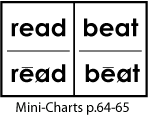
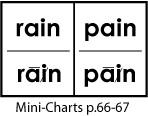
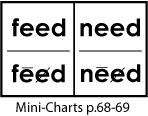

- Say, “Today, we are going to learn about one of the long vowel rules called Talking and Walking. Point to Sing Your Way Through Phonics Vol. 1 Mini-Chart p. 64 and say, "When two vowels are side-by-side in a word, the first vowel is long and the second vowel is silent. So we say it this way, 'When two vowels go walking, the first one does the talking and the second one does the walking.' Ask students to repeat this jingle with you. Point to the word read and say, "In the word read, which vowel does the talking?" (e) "What does it say?" (/ē/) "Which vowel does the walking?" (a) "What does it say?" (nothing) Say, "What symbol tells you that the e is long?" (long line) "What symbol tells you that the a is silent?" (There is a line through the letter.) Point to the word beat on p. 65. Say, "Which vowel is long and which vowel is silent?" (The e is long and the a is silent.) Sound and blend the word beat together.
- Point to the word rain (Mini-Chart p. 66) and say, "In the word rain, which vowel does the talking?" (a) "What does it say?" (/ā/) "Which vowel does the walking?" (i) "What does it say?" (nothing) Sound and blend the word rain together. Repeat this process with the word pain.
- Point to the word feed (Mini-Chart p. 68) and say, "In the word feed, which vowel does the talking?" (e) "What does it say?" (/ē/) "Which vowel does the walking?" (the second e) "What does it say?" (nothing) Sound and blend the word feed together. Repeat this process with the word need.
- Point to the word boat (Mini-Chart p. 70) and say, "In the word boat, which vowel does the talking?" (o) "What does it say?" (/ō/) "Which vowel does the walking?" (a) "What does it say?" (nothing) Sound and blend the word boat together. Repeat this process with the word coat.
- Play Talking and Walking (Track 15 on Sing Your Way Through Phonics Vol.1 CD) and ask children to see if they can join in the song while pointing to the target words on the Mini-Charts. Say, "Notice that this is an echo song. Each time a word is spelled, it is repeated. Divide the class into two groups. Play the CD again, alternating phrases between group 1 and group 2 as follows: (Group 1) r-e-a-d, (Group 2) r-e-a-d, (Group 1) has two vowels., (Group 2) What's the rule?, (Group 1) The first one does the talking. (Group 2) The second one does the walking. (Group 1) What's the word?, (Group 2) The word is read. [Continue in this manner until the song is complete.]
- Play the CD again, and ask Group 1 to sing the part that Group 2 sang and vice versa.
- Review the Talking and Walking rule aloud together, "When two vowels go walking, the first one does the talking and the second one does the walking." Ask, "Which vowel is long?" (the first vowel). "Which vowel is silent? (the second vowel)
Follow-up:

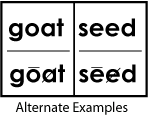
- Practice singing Talking and Walking daily for a week. Then try singing the song without hearing the words, using the instrumental track (Track 16). Allow different students to point to the Mini-Charts words while singing.
- Help students create other sets of two-vowel words for the song. Make 8 copies of Mini-Chart Template B on p.96 and allow students write in the new sets of words. Examples: ea-beak, hear, speak, ai-sail, paid, pail, ee-feet, feel, seed, oa-goat, toad, coal. Place these pages back-to-back in page protectors in a 3-ring binder. Then sing the song with the instrumental version (Track 16).
Extensions:



- Introduce the Read-and-Sing Book, Talking and Walking. As readers sing along with the lively song set to the folktune Frere Jacques, they can follow clues in the illustrations and point to the letters in each two-vowel word. In this book, characters in a camping story act out the two-vowel rule in the course of their adventure. The character representing the long vowel does the talking, while the character representing the silent vowel is walking, but not talking. Because of the predictable text, children can read along as they sing the song. Children can learn about additional long vowel spelling patterns in the Read-and-Sing book, Silent E. Keep a few copies of the book at a literacy center equipped with headsets so that students can gain practice in listening, singing, and reading two vowels togetherl rhyming words.
- Create tachistoscopes by cutting slits in a die-cut seal, goat, sheep, or snail to practice these two-vowel spelling patterns. (See illustrations to the right.) Cut a strip of card stock the width or the slits and print several word beginnings down the length of the strip. Thread the strip through the slits so that the word beginning is visible. Students can pull the strip upward or downward to create new words with the same two-vowel spelling pattern. Fold the ends of the strip so that it will not be accidentally pulled through the slits.
- Use dried lima beans to create letter tiles. Print a letter on each lima bean. Children scramble and unscramble the beans to form words with the two-vowels-together spelling patterns.
- Play the instrumental version of Talking and Walking (CD track 16) and use the Mini-Chart Templates to create words with the ie and ue spelling pattern. Examples:died, lied, tied, dies, lies, pies, blue, clue, true, glue.
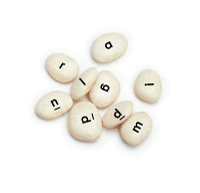
Evaluation:
- Students read all the words on Mini-Charts pp.64-71 without assistance.
- Students correctly produce the sounds of vowels ea, ai, ee, oa, ie, and ue.
Order our cost-saving Sing Your Way Through Phonics Volume 1 Combo online ($33.95) containing the CD, Mini-Charts, Song Lyrics, and Teaching Suggestions — everything you need for this lesson! Or, print out an order form to mail/FAX to us.
